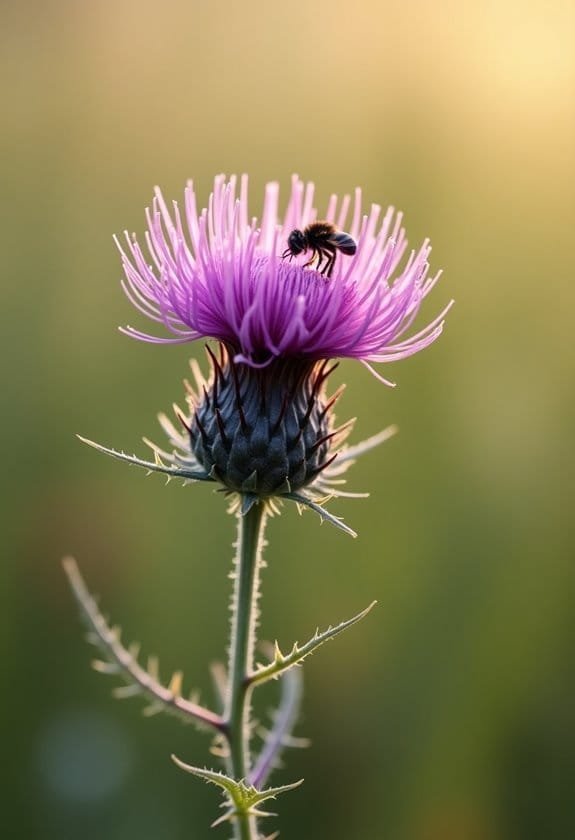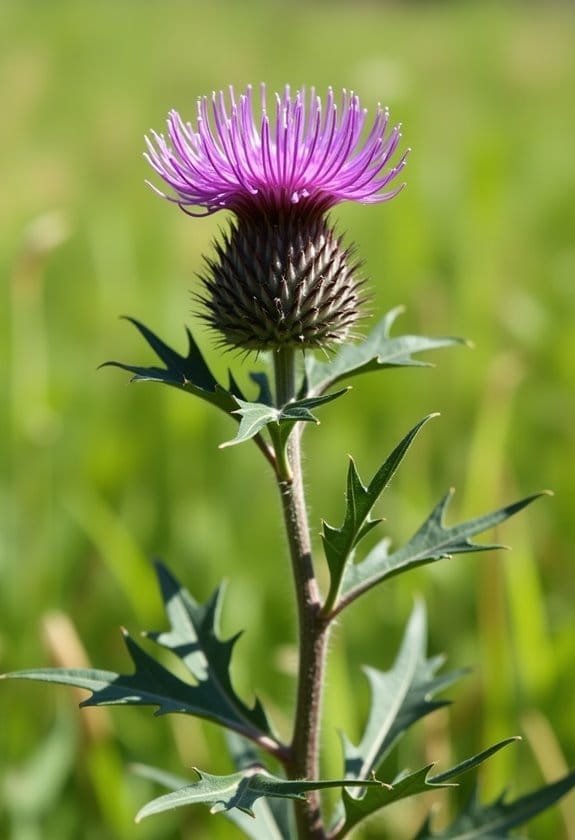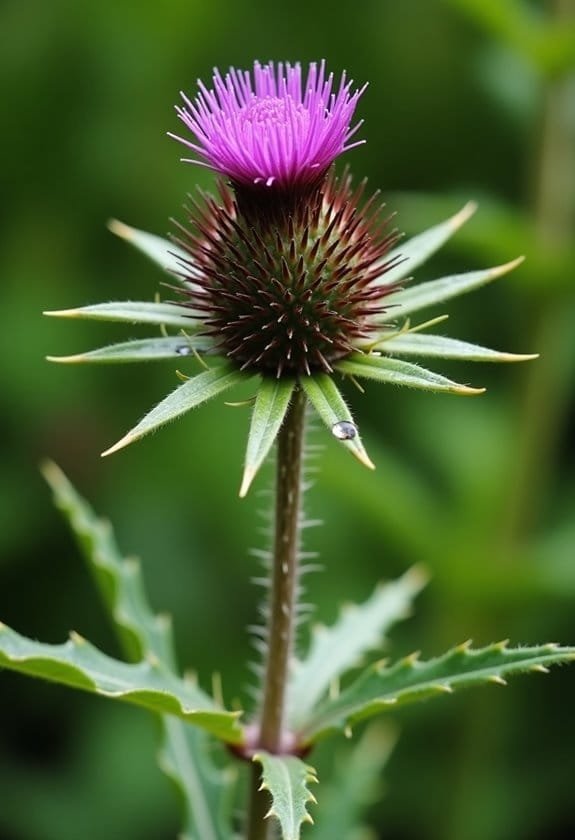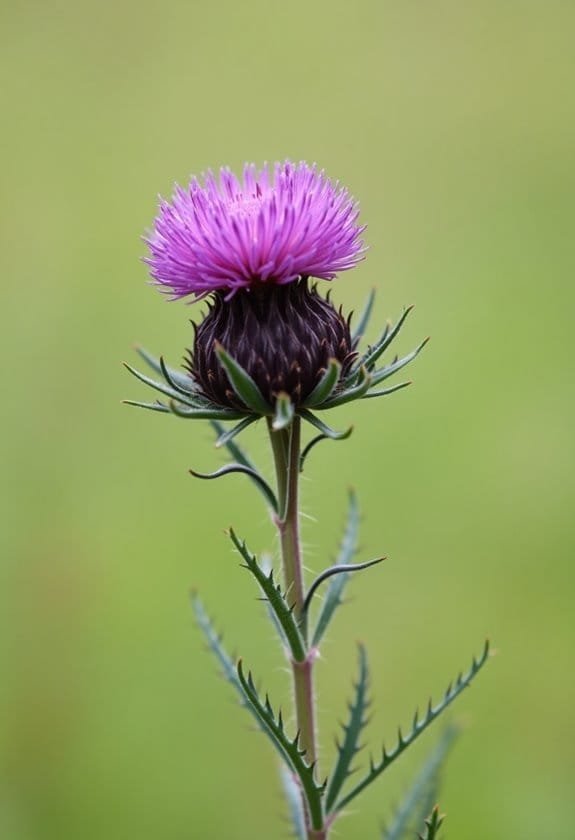Common knapweed (Centaurea nigra) is a hardy perennial wildflower that reaches heights up to 5 feet, featuring distinctive purple-pink flower heads and black-fringed bracts. It's known for its deeply lobed, hairy leaves and robust woody taproot system that enables remarkable drought tolerance. While it serves as an essential nectar source for over 70 insect species, including bees and butterflies, it's classified as invasive in some regions due to its aggressive growth patterns. The plant thrives in full sun to partial shade and adapts to various soil conditions, though its management requires careful consideration of both its ecological benefits and potential threats to native ecosystems.
Main Points
- Common knapweed is a perennial plant reaching up to 5 feet tall with purple flowers and black bracts blooming June to September.
- The plant features deeply lobed, hairy leaves, ribbed stems, and a woody taproot system that enables robust growth.
- Each flower head contains 40-100 individual florets, attracting over 70 different insect species including bees and butterflies.
- Knapweed thrives in full sun and well-drained soils, showing strong adaptability to both acidic and alkaline conditions.
- While valuable for pollinators, it's classified as invasive in some regions due to aggressive growth and abundant seed production.
Introduction

Common knapweed (Centaurea nigra var. radiata) stands as a formidable perennial plant that has garnered significant attention due to its invasive nature.
This robust species, which can reach impressive heights of up to 5 feet, features distinctive purple flowers adorned with characteristic black bracts that set it apart from similar flowering plants.
While the plant's vibrant blooms serve as valuable resources for pollinators during its June-to-September flowering period, its aggressive growth patterns and ability to outcompete native vegetation have led to its classification as a restricted species in various regions, including Wisconsin.
Common Name
Known throughout various regions by several distinctive names, this hardy plant carries multiple popular identifiers including lesser knapweed, hardheads, Spanish buttons, and bachelor's buttons. The diversity of common names reflects the plant's widespread recognition and cultural significance across different communities and geographical areas.
The scientific community formally recognizes this species as Centaurea nigra var. radiata, but its colloquial names often stem from its physical characteristics and historical uses. The term "hardheads" aptly describes the plant's robust nature and firm flower heads, while "Spanish buttons" likely references the button-like appearance of its flower buds. These descriptive names have become deeply ingrained in local traditions and botanical literature.
In Wisconsin's regulatory framework, common knapweed's classification as a restricted species has led to increased awareness and recognition of its various names among land managers and conservationists.
Despite its invasive status in certain regions, the plant's striking purple blooms and distinctive black bracts have contributed to its widespread recognition among both botanical enthusiasts and casual observers.
Scientific Name
The scientific classification Centaurea nigra var. radiata places common knapweed within the diverse Asteraceae family, reflecting its taxonomic relationship to other composite flowers. This classification system provides vital insights into the plant's evolutionary history and biological characteristics, which are fundamental to understanding its role in various ecosystems.
The genus name Centaurea carries a fascinating etymological connection to ancient Greek mythology, deriving from the centaur Chiron, who was renowned for his extensive knowledge of medicinal plants.
The specific epithet "nigra," meaning black in Latin, aptly describes the distinctive dark coloration of the flower's protective bracts, which serve as a key identifying feature of this species.
This perennial herbaceous plant, standing 40 to 70 centimeters tall, produces impressive flower heads containing between 40 to over 100 individual florets in shades of purple to white.
The botanical nomenclature not only serves taxonomic purposes but also provides valuable information about the plant's physical characteristics and historical significance in traditional medicine, making it an essential reference point for botanical research and classification.
Overview
While botanical nomenclature provides scientific precision, understanding common knapweed's broader characteristics reveals its significant impact on various ecosystems. This resilient perennial plant, reaching heights of up to 5 feet, has established itself as both a beneficial pollinator resource and a concerning invasive species in various regions.
Common knapweed distinguishes itself through its striking purple flowers and distinctive black bracts, which emerge during its blooming period from June through September. The plant's robust structure, featuring erect stems and hairy leaves, enables its successful colonization of diverse habitats, particularly in well-drained soils and sun-exposed locations.
Despite its aesthetic appeal and value to pollinators such as bees and butterflies, the species' aggressive reproductive capabilities have led to its classification as a restricted plant in Wisconsin.
Its ability to produce abundant seeds, coupled with efficient dispersal mechanisms through human activities, has resulted in significant ecological challenges. The plant's competitive nature allows it to dominate native vegetation communities, potentially reducing local biodiversity in affected areas.
Key Features
Common knapweed stands as a robust perennial herb, reaching heights of up to 1 meter with distinctive ribbed stems and lance-shaped leaves that extend to 25 centimeters.
Its most striking feature appears in the form of purple to white flower heads, each containing an impressive array of 40 to 100 individual blooms arranged in hemispherical clusters at the branch tips.
These vibrant flowers emerge during the peak growing season from July through September, transforming the plant into a crucial nectar source for various pollinators.
Growth Size
At maturity, knapweed stands as a robust perennial reaching heights of up to 1 meter, supported by its distinctive ribbed stems. This imposing stature allows Centaurea nigra to compete effectively with surrounding vegetation in various habitats, while its sturdy framework provides essential structure throughout the growing season.
The plant's substantial size is complemented by its impressive foliage, with leaves extending up to 25 centimeters in length. These deeply lobed leaves, adorned with a characteristic hairy texture, spread along the stem's length, creating a balanced architectural form that enhances the plant's overall presence.
Below ground, a woody taproot system extends deep into the soil, anchoring the plant and enabling it to access nutrients and moisture from multiple soil layers.
During the flowering period from June to September, the plant's impressive dimensions are further enhanced by its abundant flower heads. Each head can house between 40 and 100 individual flowers, ranging in color from deep purple to white, creating a striking visual display that crowns the plant's considerable height.
Appearance
The distinctive profile of Centaurea nigra emerges from its characteristic features, making it readily identifiable in meadows and grasslands. Common knapweed displays erect, stiff stems that showcase prominent ribbing and a noticeably hairy texture, typically reaching heights between 40 and 70 centimeters.
The plant's foliage exhibits a subtle variation in form, with lower leaves presenting distinct lobes while upper leaves maintain a simpler, narrower shape. All leaves share a dull green coloration and fine, hair-like covering that contributes to their muted appearance.
The flower heads command attention with their array of small, primarily purple blooms, though yellow and white variations occasionally occur. These vibrant clusters are embraced by distinctive dark-brown bracts, arranged in an overlapping pattern reminiscent of roof tiles, creating a sophisticated architectural element to the plant's structure.
The plant's reproductive features include small, tan achenes measuring 2-3 millimeters in length, equipped with minute dark pappus that facilitates wind-driven seed dispersal, ensuring the species' continued propagation across various habitats.
Flowering Season
During peak summer months, Centaurea nigra bursts into spectacular bloom, marking the start of a flowering period that stretches from June through September. Common Knapweed's vibrant display features densely packed flower heads, each containing between 40 and 100 individual blooms that produce abundant nectar and pollen resources.
The plant's extended flowering season makes it particularly valuable for wildlife, as its purple flowers, which occasionally appear in pink or white variations, provide sustained support for diverse pollinator populations. Throughout the summer, these intricate blooms become buzzing hubs of activity, attracting numerous species of bees, butterflies, and other beneficial insects that depend on their nectar-rich offerings.
A remarkable characteristic of Common Knapweed's flowering season is its ability to complete its initial bloom cycle by late July. This timing creates an opportunity for land managers to implement strategic cutting regimes, potentially stimulating a second flush of flowers later in the season, which further extends the plant's ecological benefits and enhances its value as a wildlife resource.
Growing Requirements

Common knapweed's resilient nature makes it well-suited to a variety of growing conditions, though it shows a marked preference for full sunlight and well-drained terrain.
The plant demonstrates remarkable soil adaptability, thriving in both acidic and alkaline environments while maintaining robust growth in locations where grass competition remains moderate.
Its temperature tolerance and modest water requirements allow it to flourish in meadows and grasslands, particularly in areas where natural rainfall provides sufficient moisture without the need for supplemental watering.
Light
Sunlight plays an essential role in common knapweed's development, with this hardy plant thriving best in full sun to partial shade conditions. While demonstrating remarkable adaptability across various light environments, the plant consistently shows ideal growth and flowering when exposed to abundant sunlight.
During its vital blooming period from June through September, common knapweed harnesses the extended daylight hours to produce its distinctive purple flowers. The plant's natural habitat in meadows, grasslands, and road verges reflects its inherent preference for sun-drenched locations, where it can maximize photosynthetic efficiency and energy production.
Although common knapweed demonstrates resilience by surviving in partially shaded environments, its overall vigor and floral display become noticeably diminished under reduced light conditions.
The relationship between light exposure and the plant's success is particularly evident in its reproductive cycle, as specimens growing in full sun typically produce more abundant and vibrant blooms than their shade-dwelling counterparts. This direct correlation between sunlight availability and plant performance underscores the species' evolutionary adaptation to open, well-lit habitats.
Soil
Across diverse soil conditions, common knapweed demonstrates remarkable adaptability, thriving in both acidic and alkaline environments. This resilient perennial showcases its versatility by establishing robust root systems in well-drained soils, which provide ideal growing conditions for its extensive root network.
The plant's remarkable soil tolerance extends to moisture levels, allowing it to flourish in locations ranging from relatively dry areas to moderately damp terrain. Like a pioneering settler, knapweed often establishes itself in disturbed habitats, where its hardy nature enables successful colonization of poor or compacted soils that might challenge less adaptable species.
While knapweed's ability to grow in various soil conditions makes it an impressive survivor, careful management of soil nutrients becomes crucial for sustainable growth.
The plant's vigorous nature can gradually deplete soil resources if left unchecked, particularly in areas where it forms dense colonies. Gardeners and land managers should monitor soil health, as maintaining balanced nutrient levels preserves both the plant's health and the long-term sustainability of its growing environment.
Water
In harmony with its flexible soil requirements, common knapweed's water needs reflect its adaptable nature. While the plant demonstrates remarkable resilience in various moisture conditions, it shows a distinct preference for environments that maintain consistent soil moisture without becoming waterlogged.
During its establishment phase, common knapweed benefits from regular watering to develop a robust root system, particularly in well-drained soils where moisture retention might be limited.
Once established, however, the plant exhibits impressive drought tolerance, drawing upon its deep root structure to access water reserves during dry spells. In natural settings, common knapweed thrives in locations where moderate rainfall or ground moisture is available, such as meadows and grasslands with adequate drainage.
While supplemental watering can enhance flowering performance and overall vigor, particularly during extended dry periods, excessive irrigation isn't necessary for this hardy plant's survival. The species' ability to balance water efficiency with growth requirements makes it particularly well-suited to areas where rainfall patterns may be irregular, contributing to its success in both managed gardens and natural landscapes.
Temperature
The temperature requirements of common knapweed demonstrate its remarkable versatility as a hardy perennial. This adaptable plant flourishes in temperate climates, where it can maintain ideal growth within a temperature range of 15°C to 25°C (59°F to 77°F), making it well-suited for diverse environmental conditions.
Like a resilient survivor, common knapweed has developed impressive temperature tolerance mechanisms that enable it to thrive in various habitats. While it shows a clear preference for warm conditions, the plant's ability to withstand temperature fluctuations contributes to its success in disturbed areas and along roadsides, where environmental conditions can be unpredictable.
This adaptability extends to its capacity to endure cooler temperatures, though extreme conditions can pose challenges to its development. However, prolonged exposure to temperature extremes, whether scorching heat or severe frost, can impede the plant's growth patterns and flowering potential.
For ideal results, common knapweed performs best in moderate temperature zones that align with its natural preferences, allowing it to establish robust colonies in grasslands and meadow environments.
Pollinator Criteria
Common knapweed serves as a crucial nectar source, attracting an impressive array of pollinators including honey bees, butterflies, and various species of moths.
The plant's vibrant purple flowers act as beacons for these insects, particularly drawing large skippers, painted ladies, and red admirals during its extended summer flowering period from June to September.
Research has shown that a single common knapweed plant supports approximately 70 different insect species, making it an essential cornerstone for pollinator populations in meadows and grassland ecosystems.
Attracted Pollinators
Knapweed's vibrant flowers serve as an essential nectar source that attracts an impressive range of pollinators, including honey bees and butterfly species like painted ladies and red admirals. The plant's remarkable ability to produce abundant nectar and pollen resources supports approximately 70 distinct insect species, making it a cornerstone of pollinator diversity in both urban and rural environments.
During its extended flowering period from June through September, knapweed functions as a reliable feeding station for numerous pollinating insects, providing critical sustenance throughout their active season. This continuous availability of resources plays an important role in supporting these insects' complex life cycles and habitat requirements.
Research has demonstrated that knapweed's nectar production considerably exceeds that of many competing flora, establishing it as a premier food source for pollinator populations.
The plant's presence in natural meadows and grassland ecosystems creates a ripple effect of biological enhancement, as the diverse pollinator communities it supports go on to facilitate the reproduction of countless other plant species, strengthening the entire ecosystem's resilience and biodiversity.
Pollination Method
Through its specialized flower structure, common knapweed employs a highly effective pollination strategy that relies on the coordinated efforts of various insect visitors. The plant's hermaphroditic flowers feature both male and female reproductive parts, which work in concert to maximize cross-pollination opportunities when pollinators arrive to collect nectar.
The pollination process begins when insects, particularly bees and butterflies, are drawn to the vibrant purple blooms during the peak flowering months of June through September. As these pollinators move between flowers seeking nectar, they inadvertently transfer pollen grains from the anthers of one flower to the stigma of another, facilitating genetic exchange within the population.
This cross-pollination mechanism is particularly successful due to the plant's extended flowering period and abundant nectar production, which guarantees a steady stream of insect visitors. The efficiency of this pollination method is evident in the plant's reproductive success, as successful pollen transfer leads to viable seed production and helps maintain genetic diversity throughout knapweed populations in their native habitats.
How Does Common Centaury Differ from Common Knapweed in Appearance and Uses?
The common centaury plant is a delicate wildflower with small, star-shaped pink blossoms and slender green stems, often found in meadows and woodland edges. In contrast, common knapweed displays larger, thistle-like purple flowers on sturdier stems. While the centaury is prized for medicinal uses, knapweed mainly supports pollinators in ecosystems.
Care & Maintenance

Common knapweed's successful cultivation starts with selecting well-drained soil and a sunny location, ensuring ideal conditions for root development and robust growth.
Regular maintenance includes strategic mowing before flowering and hand-pulling of unwanted plants, which helps control its spread while preserving desired specimens within the garden space.
The plant thrives alongside native meadow species and drought-tolerant perennials, creating a balanced ecosystem that supports local pollinators while maintaining biodiversity in the landscape.
Planting Tips
Successful cultivation of common knapweed begins with proper seed sowing in either autumn or early spring. These timing choices allow the seeds to establish themselves naturally before the peak growing season, maximizing their chances of successful germination and robust growth.
When selecting a planting location, gardeners should prioritize areas that receive abundant sunlight or partial shade, as common knapweed demonstrates remarkable adaptability to various light conditions. The plant's versatility extends to its soil preferences, thriving in both acidic and alkaline environments, provided the ground offers adequate drainage.
During the establishment phase, consistent watering becomes vital, particularly during periods of drought or limited rainfall. To promote ideal development, it's important to maintain a natural growing environment around the knapweed plants. This means avoiding excessive mowing or trimming of surrounding vegetation, as the species flourishes in less-managed areas.
While common knapweed's resilient nature makes it an attractive choice for naturalized gardens, monitoring its spread is vital to prevent it from overwhelming neighboring plant communities through aggressive self-seeding.
Ongoing Care
Proper maintenance of common knapweed requires a strategic approach that balances control measures with ecosystem preservation. Regular monitoring throughout the growing season is important to identify flowering patterns and implement timely control measures before seed production occurs.
Effective management involves combining mechanical and chemical control methods. Plants can be hand-pulled or mowed before they flower, while targeted herbicide applications using glyphosate or clopyralid provide chemical control when necessary.
After treatment, it's essential to restore the affected area by seeding native plant species, which helps prevent common knapweed from re-establishing and promotes biodiversity.
Maintaining soil health plays a significant role in long-term control strategies. Property owners should minimize soil disturbance and monitor nutrient levels, as common knapweed can greatly deplete soil resources if left unchecked.
Community involvement in monitoring and control efforts strengthens the effectiveness of management programs, creating a coordinated response to this invasive species. Regular assessment of control methods and adjustment of strategies guarantees successful long-term management of common knapweed populations.
Suggested Companions
While managing common knapweed requires careful attention, selecting appropriate companion plants enhances its beneficial qualities in the garden. Its sun-loving nature makes it particularly compatible with drought-resistant wildflowers and native grasses that share similar growing requirements.
Common knapweed's extended flowering period from June through September creates excellent opportunities for companion planting with species that bloom at different times throughout the growing season. The plant's ability to attract diverse pollinators, including bees and butterflies, makes it an invaluable addition to gardens featuring other nectar-rich flowers and herbs.
When establishing companion plantings, gardeners should consider incorporating early spring bloomers and late autumn flowering species to create a continuous succession of blooms.
For ideal growth conditions, common knapweed thrives alongside plants that prefer well-drained soils and can tolerate similar moisture levels. Native wildflowers such as yarrow, ox-eye daisies, and bird's-foot trefoil make particularly suitable companions, as they share similar habitat preferences and contribute to creating a naturalistic meadow environment that supports local biodiversity.
Common Issues
Common knapweed faces relatively few pest and disease challenges in its non-native environments, which partly explains its successful invasion of new territories.
Root-boring weevils and certain fungi can affect the plant's vigor, though these natural controls rarely cause significant damage in North American settings.
Agricultural specialists have explored biological control methods using specialized insects and pathogens, but implementation requires careful consideration to avoid unintended consequences on native plant species.
Pests/Diseases
A notable characteristic of knapweed is its strong resistance to most pests and diseases. While the plant generally maintains robust health throughout its lifecycle, certain environmental conditions can make it susceptible to specific pathogens. In particularly wet conditions, fungal infections may develop, leading to leaf spots or root rot that can compromise the plant's vigor.
Though knapweed doesn't typically suffer from severe pest infestations, it does interact with several specialized insects that can affect its growth patterns. The knapweed root weevil (Cyphocleonus achates) targets the plant's root system, while gall flies (Urophora species) focus their attention on the seed heads.
These interactions, rather than being purely destructive, often serve a beneficial ecological purpose by helping to control knapweed populations, especially in areas where the plant has become overly abundant.
Despite its natural resilience, regular monitoring of knapweed's health remains important, as sudden changes in the plant's condition might indicate underlying issues that require attention. The plant's competitive growth habit typically guarantees its survival even when faced with these challenges.
Solutions
Managing knapweed effectively requires a multi-faceted approach that combines several control methods. For black knapweed infestations, mechanical removal through careful hand-pulling proves most effective when the entire taproot system is extracted, particularly in smaller areas where individual attention is feasible.
Strategic mowing before flowering stages disrupts the plant's reproductive cycle and gradually depletes its energy reserves.
Chemical control methods serve as powerful allies when properly timed and integrated with mechanical strategies. Targeted applications of herbicides like glyphosate or 2,4-D deliver ideal results during the plant's active growth phases, though careful consideration must be given to minimize impact on neighboring vegetation.
The introduction of biological control agents, specifically gall flies, has shown promising results in reducing seed production and limiting the spread of established populations.
Following any control measures, it's vital to implement a thorough restoration plan. This includes reseeding treated areas with native species to prevent reinvasion and establishing a monitoring schedule to track treatment effectiveness and promptly address any new knapweed emergence.
Regular site assessments help guarantee long-term success in managing this persistent invader.
Summary

Throughout North America's diverse landscapes, common knapweed stands as both a beneficial pollinator plant and an invasive threat. This robust perennial, reaching heights of up to 5 feet, showcases distinctive purple blooms that attract a wide array of beneficial insects during its extended flowering period from June through September.
While common knapweed's contribution to pollinator populations remains significant, its aggressive nature poses substantial challenges to native ecosystems, particularly in regions like Wisconsin where it's classified as a restricted species. The plant's remarkable reproductive capacity, facilitated by its prolific seed production and woody taproot system, enables it to establish dominant colonies that diminish local biodiversity.
Management of this complex species requires a balanced approach, considering both its ecological benefits and invasive tendencies. Multiple control strategies, including mechanical removal, targeted herbicide applications, and biological control using specialized gall flies, have proven effective in managing its spread while preserving the delicate balance of native plant communities.
Understanding these dual aspects of common knapweed helps inform better conservation and management practices across North American ecosystems.


